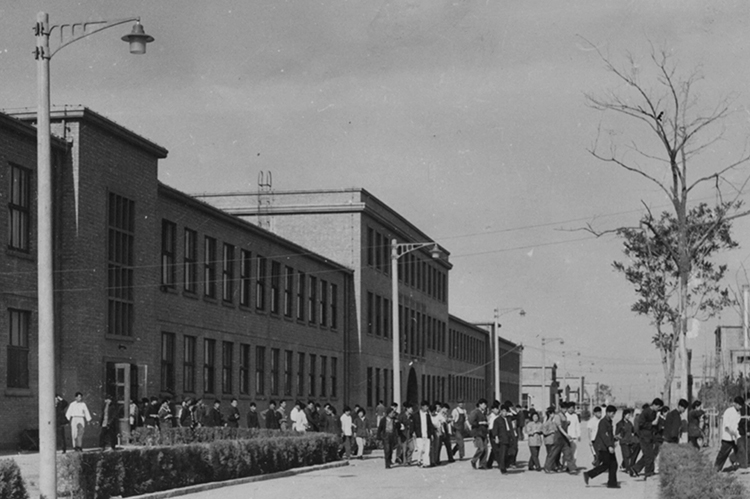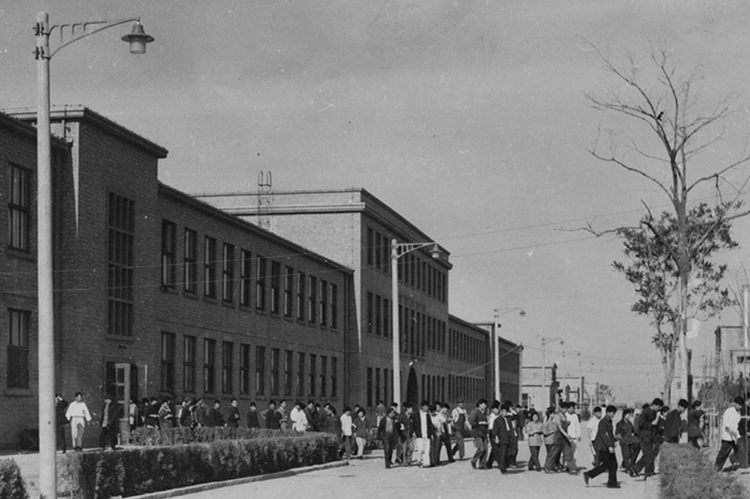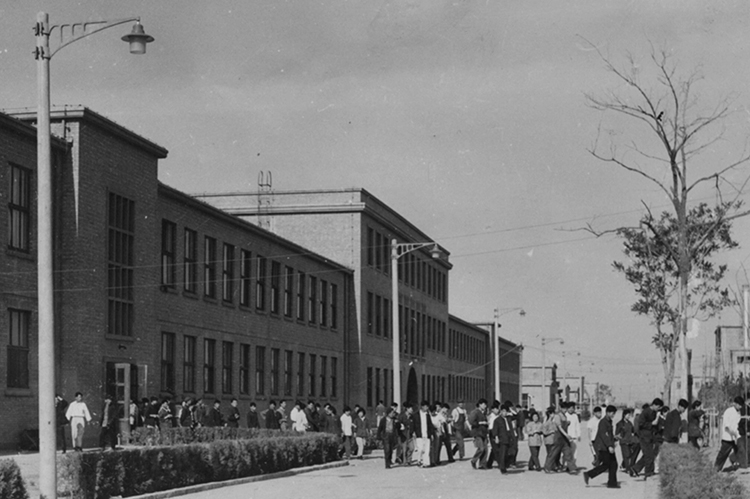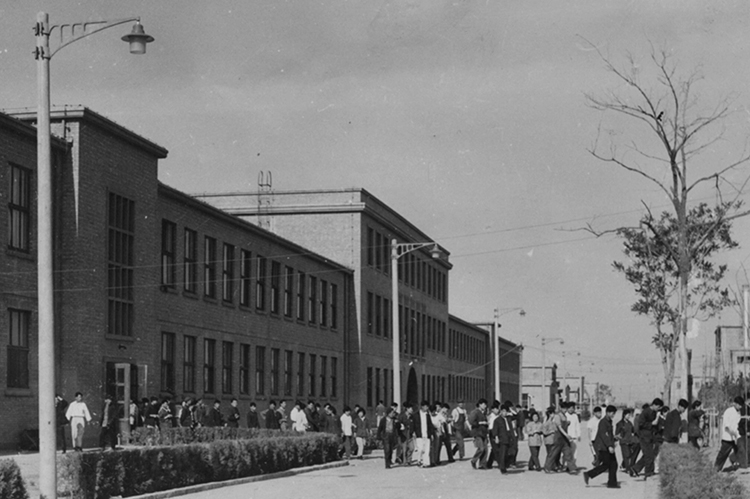

披荆斩棘,筚路蓝缕
Hack Through the Brambles and Thorns, Drive a Cart in Ragged Clothes to Break Fresh Ground
建厂项目的正式启动伴随很多细节的落实,是建厂项目实施的坚实脚印。德文班及技工班从1952年开始到1957年七一八厂开工为工厂输送了大量的人才,其中的翻译人员和技术人员在建厂项目中起到了不可或缺的重要作用。众人以建设者和创业者的姿态为之后的土建动工及工厂开工马不停蹄的推进着项目的发展,是这些忘我劳动、无私贡献的职工造就了未来的联合厂。然而,如此庞大的建设工程实施总是伴随着各式各样的挑战。德苏两国专家在设计问题上时有争执,而设计的初稿更是因为高额的预算而使得部分项目一度停滞不前,但在所有项目参与者抱持着同一目标的坚持下,设计方案最终得以批准,项目进程披荆斩棘,向下一阶段进发。
The construction of the factory was accomplished through the details, these details are the evidence of the substantial work invested in realizing the project. From 1952 until the Factory 718 began production in 1958 a German language group and German technical group were stationed in China. These language interpreters and technical specialists provided support that cannot be overstated. This positive influence of these construction designers and business consultants created an aggressive agenda for the speedy development of the factory. The tireless contribution from this group is what ensured the future success of the incorporated factory. A construction project of this immensity is only made possible by overcoming the numerous challenges that occur along the way. German and Soviet specialists disagreed on many design specifics, the initial design proposal was first drafted based on a high-cost budget causing parts of the project to stagnate later on. In spite of setbacks, all involved parties remained committed to the singular goal of building the project. Once the final draft for the factory design received approval, the period for tackling the challenges of construction began.
1. 厂址和征地
苏联提议将厂房建在北京,而在北京城市规划中西部被列为文化区,又因北京多西北风,厂房建在东侧才不会使工业污染扩散到西部。
厂址定下后,当地农民积极支持办工厂,征地和迁坟在各方协调下顺利进行。
1. Land Acquisition
Soviet advisors recommended placing the factory in the east of Beijing for the following two reasons. The first was that city planning at the time listed Beijing’s western area as a zone for cultural development. The second accounted for the prevailing north-west winds in the city. If the factory were placed in the north-east of the city it would avoid pollution contaminating the western part of the city.
2. 1953年冬 李瑞任厂长
1953年第四季度,时任张家口副市长(主管工业)的李瑞受命调来七一八厂担任第一任厂长,当时李瑞32岁。据李瑞夫人胡振坤女士说,当年周总理问康克清同志谁出任七一八厂的厂长合适,康克清回答说李瑞为好,他很聪敏而且爱好无线电,周总理就立即决策李瑞任七一八厂厂长。
2. 1953 Winter. Li Rui Assumes Position of Factory Director
In the winter of 1953 the 32 year old Jiakou Vice-Mayor Li Rui was called upon to relocate to Beijing and assume the responsibility of Director of Factory 718. According to Li Rui’s wife, Hu Zhenkun, when Zhou Enlai asked comrade Kang Keqing who he thought suitable to run Factory 718, Kang Keqing replied Ji Rui is right, Ji Rui is smart with an acute sense for details, also he has a passion for electronics. Zhou Enlai upon hearing this immediately appointed Ji Rui to the position.
3. 德苏之间的意见争执
虽同为支援中国建设,但苏、德两国从技术、专家到处事方法都不尽相同。在基建程序上,苏联是按照初步设计、技术设计、施工设计三步审批,而东德是初步设计和施工设计两结合,其内容很不相同;苏联专家集体工作水平较高,东德专家个人技术水平在苏联同行之上,但集体领导能力则相对较弱;东德专家采用柔性设计,所需钢材和高标号水泥的比率很大,他们所设计的人防工程地下部分,由水泥钢材浇筑,壁墙较厚,还有备份出口,而苏联专家在这些方面则比较强调节约。双方意见分歧很大,冲突难以避免。
3. East German and Soviet Disagreement
Although the joint project was for the assistance of China, however the USSR and East Germany found grounds for disagreement on technology, specialists and logistics. On the basis of project development the Soviets based their plan on the three stages of initial design, technical design and construction design. The Germans on the other hand proposed combining the initial design phase with the construction design phase. The Soviet specialists were known for their high quality work when they worked as a unit. The German specialists on the other hand, were known for their talented individuals, some with skills surpassing that of the Soviets, however the Germans as a unit did not perform as efficiently as the Soviets. The Germans proposed a flexible design for the factory with a large proportion built from steel and high density concrete. The design they made for the underground shelter used cast-in-place steel-reinforced concrete with thick walls and secondary exists. The Soviets opposed these measures and offered a proposal emphasizing economic use of materials. The two sides stuck to their opposed positions and conflict was inevitable.
4. 设计代号DOC
德国方面对七一八联合厂的设计给予了一个DOC的代号。DOC是德文 Dokumente chinas的缩写,直译是“中国的文件”,而在联合厂的组织机构图里德方的标题是“ Kombinat doc”。
4. Design Number DOC
East Germany gave the Factory 718 project a DOC number. DOC stands for Dokumente Chinas and is a reference number denoting projects done in China. On the drawings kept as archives by factory, the Germans designated the project as a “Kombinat doc.”
5. 包豪斯风格
七一八厂的总设计由柏林克佩尼克区国营重型机器制造中心设计院承担,其中建筑部分由德绍( Dessau)设计院工业建筑设计室设计。德绍建筑设计院设计的厂房群是世界著名的包豪斯( Bauhaus)风格。
1919年,格罗皮厄斯(Gropius)在德国魏玛市设立了“公立包豪斯艺术学校”(后改称设计学院),“包豪斯”则是其所创立的建筑风格。而七一八厂的厂房建筑设计就是由德绍设计院设计的典型包豪斯风格。
5. Bauhaus Style
The design for Factory 718 was done at the Kopernick National Heavy Machine Manufacturing Center Design Department. The architecture proposal included design done by the Dessau Design Institute Design Department. The long rectangular factory form was influenced by design theories and styles born out of the Bauhaus School for Design (1919 -1933).
6. 1952~1957人员培训
人员培训也是建设项目如此巨大繁复的联合厂所必不可缺的一环。当时身为筹备组组长的罗沛霖先生意识到了这一点,并为三类人员培训提出了解决方案:从老厂抽调高级技术及管理人员;选拔一批专业人员并由厂长李瑞领队前往德国实习;招收中学生并设立各类训练班。同时,在建厂期间七一八厂筹备组先后举办了六届德文班,培养了上百名德语人才。
罗沛霖总工程师在筹备组期间就开始筹划解决高层、中层和基层人才的设想,布置的各项措施都得到了落实。派往老厂实习的各类人员、技工训练班培养的具有基础技术知识的技工、各个自办的学校培养出来的大、中专生和技工,在实际生产和工作中成为了各车间、工段以及生产小组的骨干。
从1952年到1957年,外语培训及技术培训的训练班先后组织了多届,而从这些训练班强化、培训出来的翻译及技术人员则成为了建设七一八联合厂的过程中最重要的主力军。
6. 1952-1957 Personnel Training
The immense endeavor to train workers for employment at the factory cannot be overstated. Luo Peilin, then in the position of Director of the Preparations Group, realized this need and proposed a three-fold plan to training the needed personnel. The first was to recruit experienced factory workers from other their present positions to relocate to Factory 718. The second was to select talented individuals including Ji Rui to travel to Germany and intern with German workers. The third strategy was to recruit high-school students to start attending a variety of training courses. In addition to these measures, in the course of the Factory 718 construction the Preparation Group headed by Luo Peilin organized a series of six courses in German, training over 100 students in the German language.
Chief Engineer Luo Peilin in his time leading the Preparations Group began a strategy for placing high-level, mid-level, and basic-level workers in suitable positions. He sent workers to old factories to intern, he organized technical training to establish understanding of skills and technical knowledge among the workers; students from technical schools all over came to Factory 718 to combine efforts in the various workshops, both as large work teams and as small production groups.
From 1952 until 1957, foreign language training courses and technical training courses were regularly offered under Luo Peilin’s direction. The strength fostered in these training programs re-made these students equipped with special language and technical skills into a talented workforce crucial to the development of Factory 718.
7. 1953.10~1954.5 初步设计方案的通过
1953年10月国家计划委员会批准工厂计划任务书并委托德意志民主共和国机械工业部电讯工业局进行设计,同年12月以阿道尔夫•黑格曼为团长的初步设计专家代表团来京向中方解释初步设计方案。
德方资料初步核算需要1.7亿元人民币,这在10元就可满足一个人一个月生活费的当时是一个天文数字。如此庞大的预算数字计委无法通过,无奈之下,罗沛霖先生压缩了一些品种和大型设备,同时秦亦山先生多次向三机部老领导反映求援,最终将预算压缩到了1.1亿元才勉强通过审核,而后来实际使用的费用仍然高达1.4亿元。
1954年5月,在各方多次修改和讨论下,第二机械工业部批准了建厂初步设计。
7. 1953.10-1954.5 The Initial Design Proposal Is Passed
In December of 1953 the members present at the National Planning Committee Meeting entrusted the German Socialist Republic and Machine Industry Department Electronic Communications Industry Bureau to carry out their design for the construction of Factory 718. In that same month Adaoerfu Heigeman, leader of the winning design team, was invited to Beijing to present his teams proposal.
The design construction called for an estimated budget of 1,700,000 RMB. At that time 10 RMB could satisfy one person’s living expenses for an entire month. At that price the project was recognized as unfeasible, however Luo Peilin did not falter, instead he shrunk the number of the products to be produced and eliminated any unnecessary large-scale equipment. At the same time Qin Jishan repeatedly addressed the transistor manufacturing department head to reflect changes in budget as Luo Peilin adjusted his demands. In the end and with great effort, the agreed upon budget of 110,000 RMB passed through inspection processes. Final cost evaluations for the project say the actual spent amount came to 1,400,000 RMB.
In May of 1954 after rounds of adjustments and discussion were had the Second Machine Industry Department approved the Factory 718 design.



